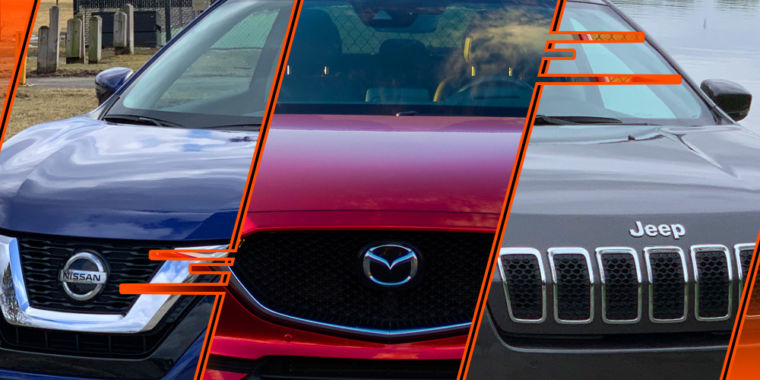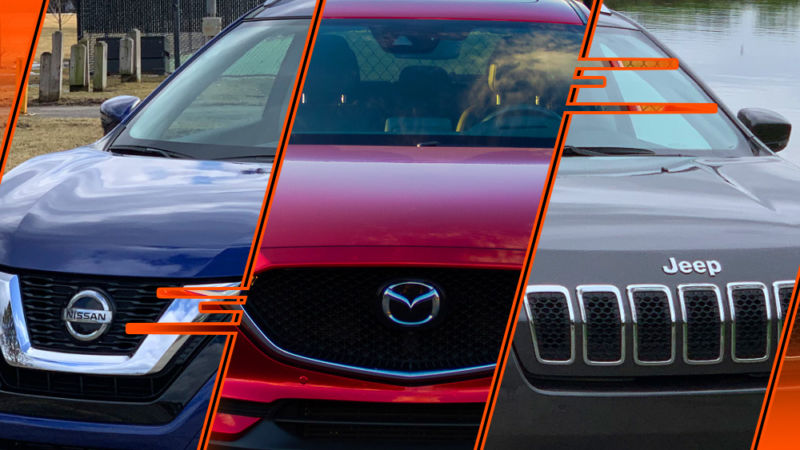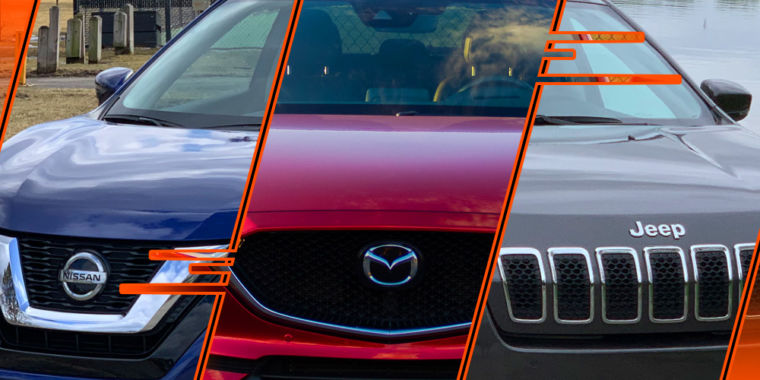
Which suv for me? —
We compare three very different compact SUVs with very similar prices.

Enlarge / The 2020 Ars FrankenSUV won’t be coming to a dealership near you.
Aurich Lawson / Eric Bangeman / Marlowe Bangeman
If you live in the suburbs of an American city, you can barely cross the street without dodging an SUV. That’s because SUVs and pickup trucks account for around 70% of new vehicle sales in the United States. With every major carmaker all-in on the form-factor, now is a great time to shop for an SUV or crossover. In a change from our usual reviews, we’re going to pit three compact SUVs head-to-head-to-head to see which one is most deserving of your hard-earned cash.
Meet the contenders
Earlier this year, I spent a week each with the Nissan Rogue SL, the Jeep Cherokee Limited, and the Mazda CX-5 Signature. All are compact SUVs that start at around $25,000, but each is built with a different goal in mind.
The Nissan Rogue is the economical, jack-of-all-trades of the three and was the fifth-best-selling vehicle in the US during 2018. It has the best mileage and lowest sticker price. The Jeep Cherokee is built for versatility with multiple driving modes for all sorts of terrain, and the Jeep badge had the highest sales growth in the US during 2018. The Mazda CX-5 is the sportiest and has the most polished interior of the lot—and it outsold all of the other Mazda lineup combined in the US during 2018.
Most importantly for our purposes, each of the cars I drove had comparable options and trim levels.
Here’s how they stack up:
| Nissan Rogue SL AWD | Jeep Cherokee Limited 4×4 | Mazda CX-5 Signature | |
|---|---|---|---|
| 2018 US sales rank (SUVs only) | 2 | 9 | 16 |
| Base MSRP | $25,020 | $25,045 | $24,350 |
| Price as configured | $36,085 | $41,220 | $39,450 |
| Dimensions | 185″ × 72″ × 69″ (4,699mm × 1,829mm × 1,753mm) | 182″ × 75″ × 68″ (4,623mm × 1,905mm × 1,727mm) |
179″ × 73″ × 65″ (4,547mm × 1,854mm × 1,651mm) |
| Wheelbase | 106.5″ (2,705mm) | 106.6″ (2,708mm) | 106.2″ (2,697mm) |
| Cargo space | 39.3ft3 (1,112L) / 70.0ft3 (1,982L) |
25.8ft3 (730L) / 54.7ft3 (1,548L) |
30.9ft3 (875L) / 59.6ft3 (1,688L) |
| EPA mileage | 27mpg (25mpg city, 32mpg highway) | 24mpg (21mpg/29mpg) | 24mpg (22mpg/27mpg) |
| Engine | 2.5L DOHC inline-4 (2.0L base) | 2.0L DOHC inline-4 turbo | 2.5L Skyactiv Turbo |
| Horsepower and torque | 170hp (125kW) at 6,000rpm / 175lb-ft (237Nm) at 4,400rpm |
270hp (199kW) / 295lb-ft (400Nm) | 227hp (166kW) / 312lb-ft (423Nm) |
| Transmission | Xtronic continuously variable transmission AWD | Nine-speed automatic AWD | Six-speed automatic AWD |
| Driving modes | Eco, Normal, and Sport | Auto, snow, sport, sand/mud, and rock | Regular and Sport |
| Driver assist system | Adaptive cruise control, lane centering, blind-spot monitoring, parking sensors |
Adaptive cruise-control, lane-keep assist, blind-spot monitoring, parking assist |
Adaptive cruise control, lane-keep assist, blind-spot monitoring, 360° parking sensors and camera, heads-up display |
| Infotainment | 7.0″ Touchscreen with buttons, CarPlay and Android Auto support |
8.4″ Touchscreen, CarPlay and Android Auto support |
7.0″ touchscreen with dial, CarPlay and Android Auto support |
Going by the eye-popping mileage and cargo space numbers, we could just declare the Nissan Rogue the winner and move on. But there’s far more to car-buying decisions than how much you’ll be spending on gas, so let’s dig in to each vehicle’s strengths and weaknesses.
On the road
-
The 2019 Jeep Cherokee Limited.
Eric Bangeman -
If it’s a Jeep, it needs a large grille.
Eric Bangeman -
As pictured: $41,220.
Eric Bangeman -
The Cherokee has a rugged look to it.
Eric Bangeman -
Only 26cu-ft of cargo space back here, unfortunately.
Eric Bangeman -
This is a sharp-looking interior.
If it’s a Jeep, it needs a large grille. -
The front row of the Cherokee.
If it’s a Jeep, it needs a large grille. -
The center console. Everything is right where you need it.
If it’s a Jeep, it needs a large grille. -
Backseat view. Not a ton of space.
If it’s a Jeep, it needs a large grille. -
White interior is beautiful, but probably not the best choice if you’re going off-roading consistently.
If it’s a Jeep, it needs a large grille.
The Mazda CX-5 is the clear winner from a drivability standpoint. Not only is it the fastest off the mark, but it’s actually enjoyable to drive, especially in sport mode, where the six-speed transmission communicates a feeling of urgency as you step through the gears. As one would expect from the company that brought us the Miata, the CX-5 is agile and precise where it needs to be. I’d have enjoyed it a bit more with an eight-speed transmission, though.
Like the other two cars, the CX-5 comes with Mazda’s suite of driver-assistance tech, including lane-keep assist and start-stop adaptive cruise control. Lane-keep assist is functional but not nearly as aggressive as other cars in the class. I did appreciate the heads-up display in the CX-5, something that’s not available in the Rogue or Cherokee.
At the other end of the spectrum, driving the Rogue is something to be endured, not enjoyed. There’s a sense of sluggishness with the Rogue, and I really disliked feeling the engine working via vibrations in the gas pedal. Nissan’s CVT doesn’t help, as its presence requires the engine to pull higher revs at similar speeds than it would with an automatic transmission. The result is a noisier ride that feels remarkably generic.
If you want the latest and greatest in driver-assist tech on the Rogue, you’ll need to spring for ProPilot Assist if you’re not going with the SL trim package. The 360° camera view is a welcome addition, making tight squeezes a little less nerve-wracking.
The Jeep Cherokee came with the optional 2.0-liter inline-four turbo, which was surprisingly sprightly. (Those looking for more towing capacity should think about the optional 3.2-liter V6.) I would have liked the Cherokee to be quicker off the mark, but at cruising speeds, tapping the accelerator pays off with a nice oomph. The ride quality is solid—passengers are insulated from nasty chunks of road, although there was slightly more road noise inside the cabin than I would have liked. Where the Cherokee surprises is with its handling, providing a sense of stability around curves. If you’re thinking primarily about off-road performance, you’ll want to look hard at the Cherokee Trailhawk. But the base Cherokee does include a sand/mud setting for those drives along… muddy beaches.
For Jeep, advanced driver-assist tech is extra. Lane-keep assist and adaptive cruise control require a $1,095 upgrade. Unlike Mazda and Nissan, Jeep does not offer a 360° parking view.
Edge: CX-5
The view from inside
-
The 2019 Nissan Rogue SL.
Eric Bangeman -
Rear view of the Rogue.
Eric Bangeman -
The Rogue is the most spacious and has the best mileage of the three SUVs, but it’s the least fun to drive.
Eric Bangeman -
Scads of cargo space back here. Note that my son was complaining about the lack of cupholders in the back seat.
Eric Bangeman -
The cockpit of the Rogue.
Eric Bangeman -
Nissan stuck a bunch of buttons to the lower right of the steering wheel. Not the smartest design move.
Eric Bangeman -
The front row.
Eric Bangeman -
Backseat passengers don’t have much to complain about.
Eric Bangeman -
I appreciated the 360° camera view in the Rogue SL.
Eric Bangeman -
The center console of the Rogue.
Eric Bangeman
One component of Mazda’s strategy to separate its crossovers from the pack is its positioning in the market. In our review of the CX-9, we described it as “90% of an Audi Q7 for 75% of the price.” That sentiment holds true for the CX-5, which really takes aim at the Audi Q3. The feel is definitely upscale, with stitched leather on the steering wheel and around the interior. The seats are comfortable and supportive, and visibility from the driver’s seat is good. Unlike Nissan and Jeep, Mazda also includes a heads-up display and ventilated seats. The backseat is adequate, as is the cargo space of 30.9cu-ft (875L). The only quibbles I have with the CX-5 regard its cheap-feeling steering wheel controls and the odd placement of the USB ports, which are at the back of the center storage bin.
Mazda’s infotainment system feels like a stripped-down version of Audi’s previous-generation MMI system. That’s not necessarily a bad thing, but the CX-5’s 7″ infotainment screen, mounted to the top of the dashboard, feels tiny and insignificant. It’s controlled by a smartly placed knob right in front of the cupholders or via touch if the car is not in motion. It gets the job done, but could have been positioned at a more driver-friendly angle. It’s also laggy, making it frustrating to use.
Compared to the the other two vehicles, the Rogue feels spacious. And it should, given the nearly 40cu-ft of cargo space. Where the Rogue falls short is in fit and finish. The seats aren’t as comfortable as the CX-5 or Cherokee, although the sight lines from the driver’s seat are good. I’ve found Nissan (and Infiniti) interiors to be bland and uninspiring, with seemingly little thought given to driver ergonomics. There are two rows of buttons above the driver’s left knee, plus a touchscreen infotainment system that feels dated. Everything you need is there, even if it’s not immediately clear where “there” is.
The Cherokee has the most stylish-looking interior, and the panoramic moonroof feels especially upscale. My biggest quibble was the thickness of the steering wheel and gear shift lever, both of which feel like they belong in a much larger car. Sight lines are good, and everything the driver needs is within easy reach. There’s a pleasing visual coherence to the cabin missing from the Nissan and Mazda. The presence of Chrysler’s Uconnect touchscreen infotainment system helps. While the competition has spent the last couple of years catching up, Uconnect is still one of the best infotainment systems available in a mainstream SUV.
Where the Cherokee falls short is room—there’s just not enough of it. That includes the meager (compared to the Rogue) 25.8cu-ft of cargo space and a slightly cramped-feeling backseat.
Edge: CX-5
Fuel economy
-
The Mazda CX-5.
Marlowe Bangeman -
The CX-5 is the best-looking SUV in this shootout for my money.
Marlowe Bangeman -
I’m not usually a fan of red cars, but this shade of cherry red does the trick for me.
Marlowe Bangeman -
Is that an evil grin?
Marlowe Bangeman -
Decent amount of cargo space back there.
Marlowe Bangeman -
The view from the rear.
-
Stylish-looking interior with comfortable seats and a solid driving position.
Marlowe Bangeman -
Dual-zone climate control and heated back seats.
Marlowe Bangeman -
Look at that itty-bitty screen.
Marlowe Bangeman -
The center console. You can switch between sporty and normal drive modes. No off-road setting, however.
Marlowe Bangeman -
I always love the 360° view camera.
Marlowe Bangeman -
The cockpit of the CX-5.
In the course of a review, I typically put between 300 and 500 miles on the car, and I use it as I would my own car. That entails driving my son to rugby practice, trips to the grocery store, visiting my in-laws who live 40 miles to the south, going to church, and a 63-mile route through the northwest suburbs of Chicago that includes country driving on two-lane winding roads, freeways, and typical suburban driving. While the driving conditions varied with the three cars (mostly the average temperature), I put roughly the same amount of miles on each one.
The big surprise here—and not in a good way—was the Rogue. It’s rated at 27mpg by the EPA (32mpg on the highway), and I got 23.9 miles to the gallon. I managed 24.1mpg with the Cherokee and 24.4mpg with the CX-5; both are rated at 24mpg by the EPA.
If you’re looking for something more than an internal combustion engine, Nissan offers a hybrid version of the Rogue rated at 34mpg. Fiat Chrysler plans to introduce a plug-in hybrid Compass and Renegade for the 2020 model year, with the Cherokee presumably to follow at some point in the not-too-distant future. Mazda, on the other hand, is focused on making its ICEs more fuel-efficient and has not announced plans for hybrids.
Edge: Rogue
And the winner is…
Going purely by the numbers, the Rogue should be the clear winner, right? After all, it offers the best mileage and most cargo space of the contenders. But the Rogue is also the least-interesting SUV of the lot, combining an uninspired design philosophy with a bland and noisy ride. Driving the Rogue felt like something to be endured, rather than embraced.
At the other end of the spectrum is the CX-5. Mazda’s performance-oriented, luxury-light approach makes for a crossover that offers the occasional flash of excitement on the highway. But some of the design choices Mazda made are grating, including minor things like USB port placement (the inside rear of the center storage compartment) and controls that feel cheap.
If you live in a place where you regularly deal with lousy roads, or if you have a yen to go off-road, the Cherokee is the best bet. And it has the most coherent look and feel of the three SUVs. But, despite having a near-identical wheelbase and comparable dimensions to the Rogue and CX-5, the Cherokee falls short on interior room. If one of your car-buying requirements is maximum space for your stuff, look elsewhere. And a fully loaded Cherokee Limited is going to be $5,000 more than a similarly equipped Nissan or Mazda.
Ultimately, each of the three SUVs has something to recommend it. Off-roading? Cherokee. Fun behind the wheel? CX-5. Space and fuel economy? The Rogue.
If I had to choose one of the three to be my daily driver, however, the CX-5 is a better all-around ride than the Jeep and Rogue.









